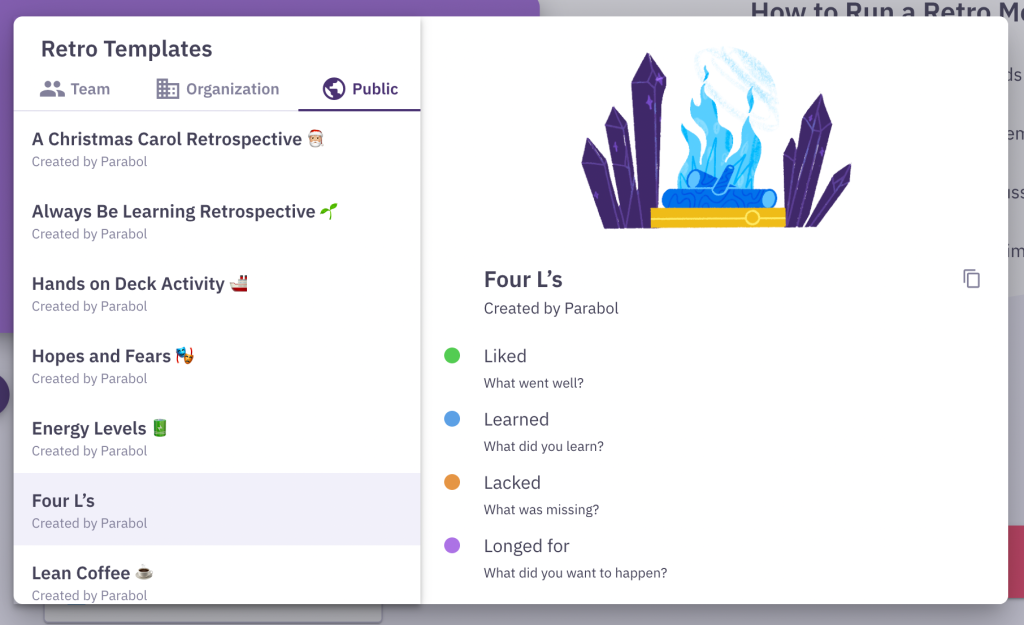4Ls Retrospective
Discover what your team liked, learned, lacked and longed for

What is a 4Ls retrospective?
Originally created by Mary Gorman and Ellen Gottesdiener, the Liked, Learned, Lacked, Longed For retrospective, also known as a 4Ls retrospective or Four Ls, is an excellent way to gather information on a team process or agile project.
Unlike the decisive language in a Start, Stop, Continue retro, the Four Ls allow for more neutral and far-reaching feedback.
This retrospective technique is less about immediate solutions and more about fact-finding, which can lead to broader, sweeping changes, or small nuanced tweaks for your next iteration.
4Ls retrospective prompts
There are four categories in this retro (compared to the usual three in other retros), so naturally you’ll end up with more data.
Here’s how the prompts break down:
Liked 👍
Things you liked, enjoyed or appreciated. These can be things about the process or the project, or even a person’s particular successes or achievements.
Example: I really liked working in pods with people of different disciplines. We should do this again next sprint
Lacked 🙁
What was missing in the last iteration or sprint? What are the things that could have improved the process? These can be anything from missing equipment to lack of knowledge.
Example: We didn’t have a cloud storage solution settled on before the sprint began
Learned 🎓
What did you learn during this iteration or sprint? Again, these can be things individuals learned, or things the team learned as a whole.
Example: I learned that amending our website style sheets takes longer than I thought
Longed For 💭
If Lacked looks toward the past, Longed For looks toward the future and adds an emotional perspective. What would have made this process smoother? What was the thing that had you thinking, “If only we had…”?
Example: Hiring just one more designer before we started would have helped even the workload
Benefits of a 4Ls retrospective
The Four Ls retro focuses on building shared knowledge. This agile retrospective template is a great way to help team members increase understanding of their respective roles and responsibilities.
It’s also a good way to find knowledge gaps and clear up misconceptions.
Expect to hear someone say, “I didn’t know you didn’t know that,” at least once.
The Ls are also fairly general terms (Learned alone could encompass all kinds of feedback, from the mundane to the profound), so you could also end up with a wide breadth of insights and action items.
When to do a 4Ls retrospective
It’s best to run a Liked, Learned, Lacked, Longed For retrospective when you need to gather data on a process, project or event that you plan to repeat, but aren’t necessarily looking to completely transform.
After implementing a large change
It’s a great retro to run after you implement a large change, or start an entirely new process because you’ll end up with a wealth of information that can help you gauge the success of those changes.
That’s because unlike the Start, Stop, Continue template, the Four Ls doesn’t require you to come up with and implement immediate solutions.
While that can bring about some hesitancy for some who aren’t sure what to say, it tends to result in a wider array of feedback. Without the pressure of having to immediately fix a problem, your team is open to discuss lessons learned and possible new strategies needed.
For deep discussions
If your team has been together a while and is comfortable with more abstract discussions, this can be a great retrospective technique to dig deep and discuss trickier topics—those things that might require bigger, structural changes.
As an all-purpose retrospective
Of course, you can also run it with a more novice team, or simply as a way to gather feedback. For example, you could run it after a conference to gain insight from attendees on what they learned and liked, and then make small changes for the next year to address things the conference lacked and attendees longed for.
Running it again after those changes should hopefully result in smaller Lacked and Longed For results.
Remember that the Learned and Liked categories mean you’ll likely get a mix of emotional and objective feedback. Some of it will be purely process-related, some of it could be personal and specific to a particular participant. That mix could help you balance changes to improve morale and efficiency.
How to run a 4Ls retrospective in Parabol
From your dashboard select your team on the right and then hit that vibrant Add Meeting button.
Select the 4Ls retrospective template in Parabol
Select Retro Meeting with the arrows, then use the dropdown to select the 4Ls Liked, Learned, Lacked, Longed For retro template. This is where you’ll find all of Parabol’s retrospective templates.

Parabol will generate an icebreaker question for you to kick off your meeting with. It’s optional, but we recommend it for getting everyone in the mood to contribute. Especially on remote teams.
Start your 4Ls retrospective with an icebreaker
If you’re doing an icebreaker, you’ll have a random question to answer. You can refresh it if you want another option, and of course you can create your own if you want. Why not ask about something your team recently learned or lacked in their personal life.

Reflect, Group, and Discuss topics based on the 4Ls retro prompts
After the Icebreaker your facilitator or scrum master will move on to the reflect stage. This is where you get into the principles of the Four Ls retro discussed above.
You’ll brainstorm ideas for the four prompts on digital sticky notes.
After your team are done brainstorming, you’ll group those topics into themes, do some dot voting to assemble your agenda, and hold your retrospective discussion. Parabol comes with a built-in timer so the facilitator can timebox any of these phases.
Finally, end the retrospective meeting by creating action items or follow up projects. Parabol integrates with Atlassian Jira and GitHub, so you can create tasks in Parabol and expert them directly to the tools you use in your everyday work.
If you like this retrospective you might like others, including the Sailboat retrospective as another classic or the Winning Streak retrospective to double down on team wins.
